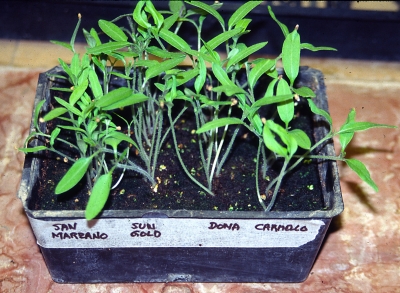TEASING APART HYDRANGEAS
/3 Comments/in Flowers, Pruning/by Lee ReichGood Answer
When someone asks me how they should prune their hydrangea, I give them the answer that most people don’t like to any question “It depends.” What else can I say? It DOES depend. One or more of a few species of hydrangeas commonly make their home in our yards, and you have to approach each, pruning shears or loppers in hand, differently.
Let me tease apart the answer by, first, taking a look a what hydrangea or hydrangeas we may be growing, and then how they grow and flower, which, in turn, speaks to when and where to start snipping away.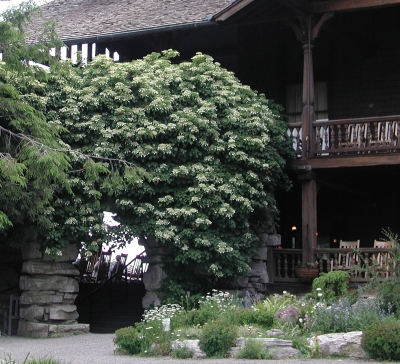
Mopheads and Lacecaps, and Oakleafs
If the hydrangea plant in question is a shrub bearing blue or pink flowers, it’s a so-called Bigleaf Hydrangea (Hydrangea macrophylla). Mopheads types, also called hortensias, bear softball to volleyball size clusters of florets. Lacecap types bear flat-topped cluster of small, hardly conspicuous florets surrounded by rims of showy, larger, 4-petalled florets.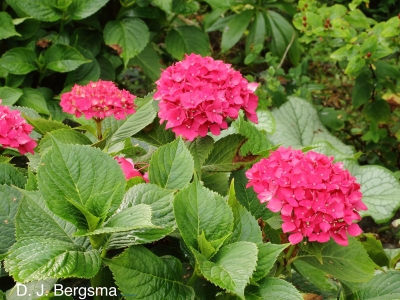
Whether mophead or lacecap, Bigleaf Hydrangeas flowers open from buds they set up the previous year. Those buds are big and fat, in contrast to the skinny buds that grow out to become shoots.
Prune Bigleaf Hydrangea stems as far as the fat buds while the plants are leafless (now, for instance). Right after bloom, cut the stems further back to near ground level.
Problem is that while the plants can stand up to bitter cold, the flower buds can’t, expiring at temperatures below about minus 5° Fahrenheit. Some varieties set their flower buds lower on the stem than do others. Their buds might more reliably stand up to winter cold if plants are mulched in late fall with some loose organic material like straw or arborists’ wood chips.
Pushing Bigleaf Hydrangea growing further north are some recently developed varieties that bloom on new, growing shoots. These new varieties — the first one of which was named Endless Summer — will bloom anywhere. Blossoms on new shoots unfurl later in the season than those on older wood, too late in some gardens (like mine, some years). Cutting back older shoots after they flower fuels a better show from the young, growing shoots.
Oakleaf Hydrangea (H. quercifolia) is another hydrangea that is very cold hardy, except for it flower buds. Flowers sit on the ends of stems in elongated clusters, like cotton candy. Oakleaf Hydrangea can be pruned just like Bigleaf Hydrangea, except that it grows as a large shrub so need not be cut back so much.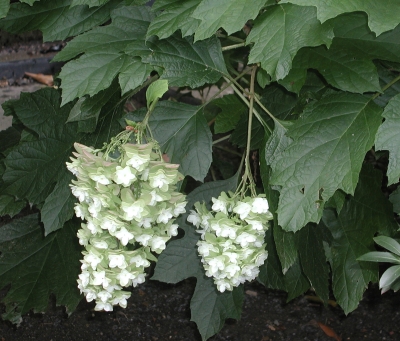
Lack of a flowery show from Oakleaf Hydrangea is no loss because a billowing mound or mounds of the oak-like leaves are attractive in their own right through summer, and also in fall, when the leaves turn rich, burgundy red. Even where winter cold would test the reliability of flowering, Oak Leaf Hydrangea is often planted solely for its form and its leaves.
A Beautiful Climber
Years ago, I planted a Climbing Hydrangea (H. animal petiolaris) at the base of the north wall of my home. It took a couple of years or more to get in gear, but now completely clothes that wall. Though leafless through winter, the peeling, light mahogany bark stands prettily against the brick red backdrop. 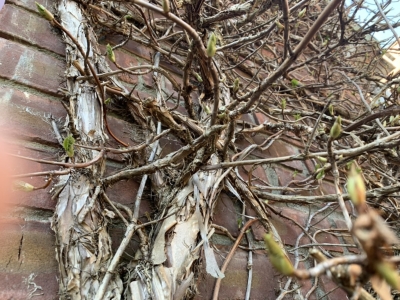 Soon the stems will be draped in glossy, green leaves and, a little after that, white flowers that stand proud of the wall on short stalks and glow against their dark backdrop like a starry night.
Soon the stems will be draped in glossy, green leaves and, a little after that, white flowers that stand proud of the wall on short stalks and glow against their dark backdrop like a starry night.
This time of year my pruning consists of shortening shorten flower stalks that reach too far out from the wall and vigorous stems that keep trying to sneak around the wall to clothe the rest of the house. Twice in summer I prune stems again to restrain the plant to only the north wall.
Perhaps I’ll plant another Climbing Hydrangea at the base of my 90 foot tall Norway spruce that with age is thinning out. The hydrangea tolerates sun or shade, and can climb a tree without causing harm.
And, Easiest of All
Rounding out this romp through pruning hydrangeas are two of the easiest to prune plants of the species. The first, Smooth Hydrangea (H. arborescens), grows long shoots from ground level, each capped in early summer with half-foot-wide clusters of of white or pastel flowers. To prune, just lop all stems right to the ground in late winter or early spring.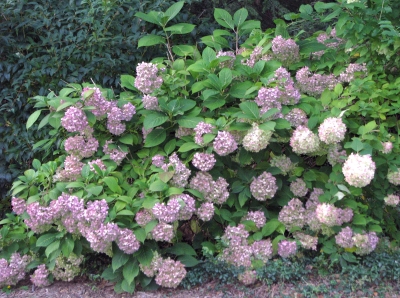
And finally, we come to PeeGee, sometimes called Panicle, Hydrangea (H. paniculata grandiflora), growing like a small tree or large shrub. This one blossoms in late summer on new growth, so if it is going to be pruned, that needs to be done before growth begins. 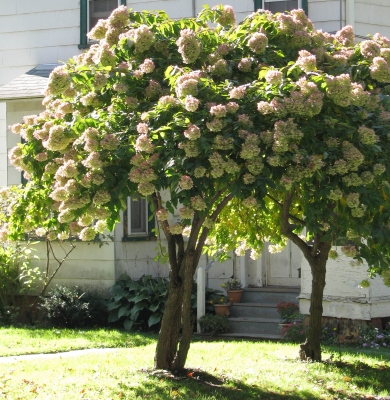 With that said, Panicle Hydrangea develops a permanent trunk or trunks, making it difficult to reach high into its dense head for pruning. No matter, because the plant flowers quite well with little or no pruning.
With that said, Panicle Hydrangea develops a permanent trunk or trunks, making it difficult to reach high into its dense head for pruning. No matter, because the plant flowers quite well with little or no pruning.
Hydrangea is only one group of closely related plants where species differ in how they are pruned. Roses would be another example; climbing roses are pruned very differently from rambling roses, which are pruned very differently from . . . you get the picture. Clematis also. For more details about the individual pruning needs of these as well as lots of other trees, shrubs, vines, flowers, fruits, and houseplants, and special pruning techniques like pollarding, mowing and scything (yes, that’s pruning!), and espalier, take a look at my book The Pruning Book. It’s available through the usual sources or, signed, directly from me here.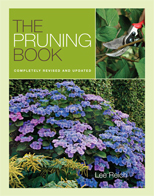
GOURMET FERTILIZER
/14 Comments/in Gardening/by Lee ReichVegetarian Plants
The other day in the hardware store I overheard someone ask the clerk for some rose food. My eyebrows went up as I thought to m’self, “Are they kidding, thinking that roses need their own special food? Next, I’ll hear about plants that prefer vegetarian or kosher food, perhaps fish emulsion on Fridays?”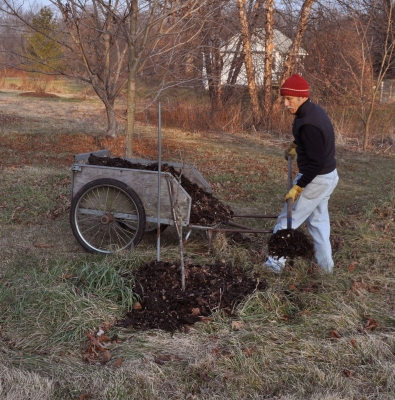
All this food science when it comes to plants may boost fertilizer sales, but it hardly bothers plants either way. Plants take up the bulk of their nutrients as ions (charged atoms or groups of atoms) that are dissolved in water in the soil. Rock particles, as well as humus and organic fertilizers, decompose to release nutrient ions slowly into the soil solution. Chemical fertilizers are already in ionic form, so when you sprinkle a handful on the soil, they dissolve as soon as they contact water.
A Well-Rounded, Wholesome Diet
What’s so special about rose food for roses? Nothing. All plants need healthy doses of nitrogen, phosphorus, and potassium, and lesser amounts of other nutrient elements. But unless a soil is an infertile sand where neither crop rotation nor some weed growth is allowed to balance soil nutrients, specific foods don’t usually have to be tailored for specific plants.
My garden grows pretty well, and I feed all my plants the same diet: An annually replenished mulch of wood chips, leaves, or compost, and, if extra nitrogen is needed, an annual sprinkling of soybean meal. Theoretically and in practice, an inch depth of compost alone provides sufficient nourishment for the plants. 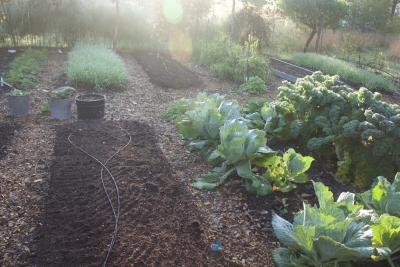 That inch depth of compost is the only thing my vegetable beds get each year, and it nourishes closely planted cabbages, tomatoes, lettuces, and other plants from the first breath of spring until cold weather barrels in to shut down production.
That inch depth of compost is the only thing my vegetable beds get each year, and it nourishes closely planted cabbages, tomatoes, lettuces, and other plants from the first breath of spring until cold weather barrels in to shut down production.
Garden plants that are pressed into sustained production (nonstop flowering of those rose bushes, for example) or vegetables best plumped up with extra-succulence, like some leafy vegetables, might need an extra push with additional nitrogen. Or not.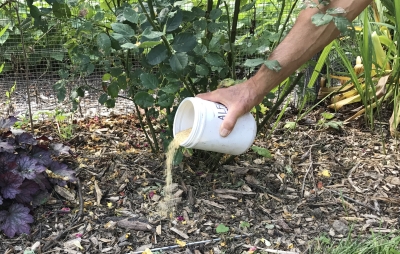
Soybean meal, available in garden centers as well as anywhere selling animal feeds, is insurance in the form of a high nitrogen, organic fertilizer. Cottonseed meal, hoof and horn meal, alfalfa meal, or blood meal would serve as well. Soil microorganisms decompose the proteins in any of these fertilizers in a series of steps to produce amino acids, then ammonium ions, then nitrate ions. The latter two ions are the forms of nitrogen most utilized by plants.
I grew Brussels sprouts unsuccessfully for many years, with sprouts hardly bigger than marbles lining up along the spindly stalks. So last year, I sprinkled some soybean meal (2 pounds per hundred square feet) on the ground before laying down the compost. Success! The plants grew into sturdy, five-foot-high stalks along which were lined up almost golfball-sized sprouts.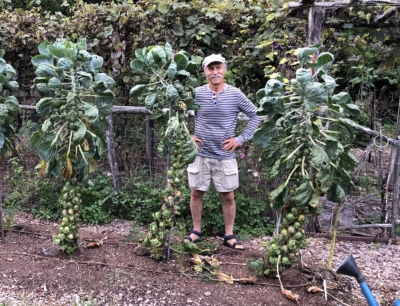
Flowers and mature trees and bushes get nothing more than arborists’ wood chips, leaves, hay, straw, or wood shavings here. Even these low nitrogen mulches eventually release nitrogen as their lower layers break down in the soil.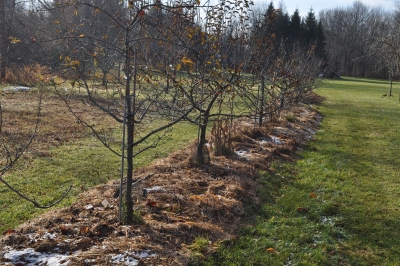
But Still . . .
You might point out that, still, there are some plants that need a specialty plant food: “acid plant food” for azaleas and rhododendrons, for example. You’ve got a point; these plants do have special needs. But my universal pabulum of mulch and soybean meal also suffices for them.
The special requirement of these plants is an acid soil. If a soil is not naturally acidic, the soil doesn’t need an “acid plant food,” it needs to be made acidic. The way to make a soil acidic is with sulfur, a naturally mined mineral. The amount needed depends on the existing soil acidity (determined with a quick soil test), the desired soil acidity (a pH of about 5 for acid-loving plants), and whether the soil is sandy or clayey. A sandy soil needs about 3⁄4# per 100 sq. ft. for each pH unit change; clay soils need about two-and-a-half times that amount. The sulfur to use is “pelletized” because it’s less dusty to work with. And, obviously, any compost for these plants should have had no added limestone.
What about the special nitrogen requirement of these plants? Commercial “acid plant food” supplies acid-loving plants with their preferred form of nitrogen, which is ammonium ion. Let’s see what happens to my soybean meal in an acid soil. A few paragraphs earlier, I wrote that though an orchestrated series of steps, various soil microorganisms gobble up proteins in soybean meal or other organic fertilizers, breaking them down to amino acids, ammonium ions, and then nitrate ions. In acidic soils, microorganisms that do that last job are absent. Breakdown stops at ammonium ion — just what those plants like best.
Plants don’t need haut cuisine, just plain, wholesome food. (More details about this in Weedless Gardening and The Ever Curious Gardener.)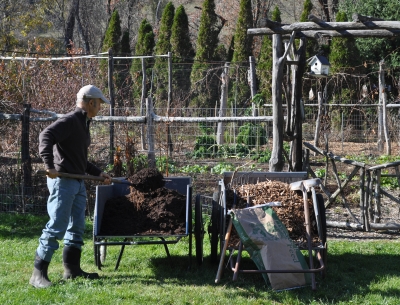
EVOLUTION AT WORK
/6 Comments/in Gardening/by Lee ReichGreen Thumb Not Needed
Anybody out there now sprinkling seeds into mini-furrows in seed flats, flowerpots, or repurposed yogurt cups? How many of us are then disappointed when, a few days later, there’s no sign of green sprouts poking up through the brown soil? Or not enough of them.
A green thumb isn’t a prerequisite for growing seedlings indoors to give plants a head start for earlier ripening of tomatoes and peppers or earlier blooms of zinnias or marigolds. Backing up every seed is 350 million years of trial and error; seeds have evolved to sprout. So why, sometimes, don’t they, and how do to right any wrongs?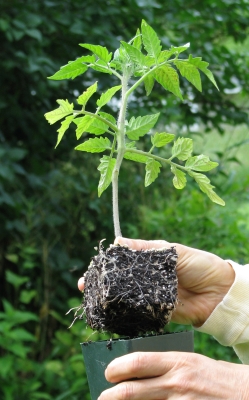
Good Seeds and Good (Potting) Soil a Must
Seeds are living, breathing creatures, and don’t live forever. How long a seed remains viable depends on the kind of seed. Longevity of vegetable seeds under good storage conditions goes from just a year for onion, parsnip, and parsley seed to more than four years for seeds of cucumber, lettuce, and cabbage and its kin. Most annual flower seeds are good for one to three years, most perennials two to four years.
But don’t take any reports of seed longevities too much at face value. Storage conditions play an important role, with the best conditions being cold and dry. I store my seeds in an airtight tub along with packets of silica gel that I weigh and refresh, if needed, in a microwave oven. The tub winters in my unheated garage and summers in my cool basement, or freezer.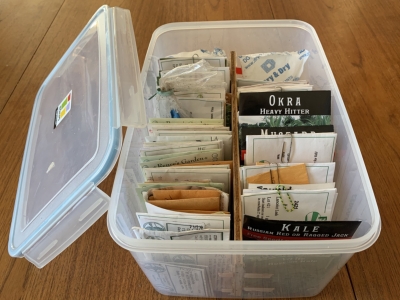
Next, turn to the soil or, more correctly, the potting mix or potting soil. Don’t sow seeds in garden soil, even good garden soil. Garden soil becomes too sodden in the confines of a container. Purchase or make your own mix (both of which I wrote about my March 15, 2022 blog post).
Gather up some bona fide or makeshift containers, and you’re ready to plant. Any container that’s a couple of inches deep with drainage hole in its bottom is suitable. Fill it with the potting mix and gently firm it.
What Next?
A guideline that I don’t follow rigorously is to plant seeds at a depth approximately four times their thickness. A lighter, airier mix warrants deeper planting or seeds will dry out too quickly. Still, bigger seeds do warrant deeper planting than smaller seeds. With really tiny seeds, like foxglove or portulaca, I just sprinkle them on the surface, perhaps with a smidgen of potting mix for a very light cover. Tiny seeds have tiny energy reserves, and if planted too deep, they burn up all their energy before peering aboveground to drink in energy-giving light. No matter the depth, right after sowing I firm the seedbed for good contact between seeds and mix.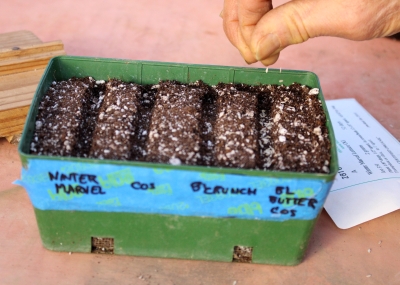
And then I water. I could water from above with a gentle “rain” from the fine rose of my watering can or hose wand, but prefer to minimize washing around the potting mix and seeds, especially small seeds, by watering from below. I set the seed flat or container in a pan with an inch or so of water and let it sit for a few hours. By then the potting mix is saturated with water; lifting the container out of the water and then tipping it at an angle drains excess (gravitational water) from the mix. A pane of glass over the top of the container prevents evaporation to lock in moisture.
All the seeds now need to coax them out of the slumber is warmth. Each kind of seed has a minimum, a maximum, and an optimum temperature for germination. Unfortunately, it’s not the same for all seeds. Between 70 and 80 degrees Fahrenheit (21-27° C.) strikes a nice balance for all of them.
Armed with a thermometer, check out warm spots around your home: perhaps it’s a warm room, the top of a refrigerator, an insulated container along with a periodically refreshed hot water bottle, or near a furnace. Electric seed heating mats are available, some raising the temperature 10° F above ambient, more expensive ones raising the temperature to whatever amount you dial in.
I made my own germination chamber from a styrofoam cooler along the bottom of which I wired two sockets each with a 15 watt lightbulb. Above the bulbs sits a rack for the seed flats. The bulbs are wired into a thermostat on which I can dial the desired temperature set, always, in my case, set to 80° F.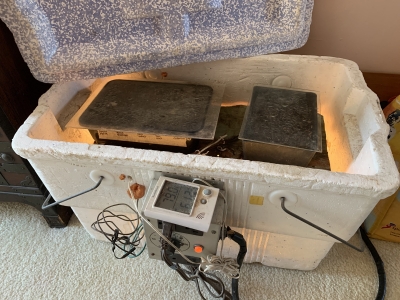
One Final Ingredient and You’re Good to Grow
That’s it, except for one final ingredient: patience. Even with ideal conditions, seeds vary in how long they take to germinate.
I check the containers every day and as soon as sprouts appear, I uncover and whisk the container to bright light. From then on, cooler temperatures — about 10° F. less than germination temperatures — and bright light are ideal.